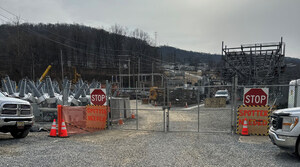FirstEnergy Ohio Utilities Seek Changes to Rate Plan to Help Ensure Long-Term Price Stability for Ohio Customers
Rehearing Request Would Preserve Customer Benefits in Recently Approved Electric Security Plan
AKRON, Ohio, May 2, 2016 /PRNewswire/ -- FirstEnergy Corp.'s (NYSE: FE) Ohio utilities today asked the Public Utilities Commission of Ohio (PUCO) to consider modifications to their recently approved Electric Security Plan (ESP IV) that would help protect customers from future retail price increases.
Today's rehearing request seeks to allow the FirstEnergy Ohio utilities – Ohio Edison, Cleveland Electric Illuminating and Toledo Edison – to use a rate mechanism to protect customers against long-term price increases and volatility by applying credits or charges to monthly electric bills.
Customers would receive credits or charges on their monthly electric bills based on the projected plant cost calculations and electric output contained in the recently approved ESP IV. Based on this information, the plan is expected to save customers hundreds of millions of dollars during its eight-year term, between June 1, 2016 and May 31, 2024, and the credits or charges would be reviewed by the PUCO both quarterly and annually.
If approved, the modified ESP IV would preserve the comprehensive benefits contained in the original plan by offering energy efficiency programs, evaluating smart grid technologies and providing low-income customer assistance.
Since the proposal is based almost entirely on evidence in the record at the PUCO, the FirstEnergy Ohio utilities are seeking a decision on their request by May 25, 2016.
FirstEnergy is dedicated to safety, reliability and operational excellence. Its 10 electric distribution companies form one of the nation's largest investor-owned electric systems, serving customers in Ohio, Pennsylvania, New Jersey, West Virginia, Maryland and New York. The company's transmission subsidiaries operate more than 24,000 miles of transmission lines that connect the Midwest and Mid-Atlantic regions, while its generation subsidiaries control nearly 17,000 megawatts of capacity from a diversified mix of scrubbed coal, non-emitting nuclear, natural gas, hydro and other renewables. Follow FirstEnergy on Twitter @FirstEnergyCorp or online at www.firstenergycorp.com.
Forward-Looking Statements: This release includes forward-looking statements based on information currently available to management. Such statements are subject to certain risks and uncertainties. These statements include declarations regarding management's intents, beliefs and current expectations. These statements typically contain, but are not limited to, the terms "anticipate," "potential," "expect," "forecast," "target," "will," "intend," "believe," "project," "estimate," "plan" and similar words. Forward-looking statements involve estimates, assumptions, known and unknown risks, uncertainties and other factors that may cause actual results, performance or achievements to be materially different from any future results, performance or achievements expressed or implied by such forward-looking statements, which may include the following: the speed and nature of increased competition in the electric utility industry, in general, and the retail sales market in particular; the ability to experience growth in the Regulated Distribution and Regulated Transmission segments and to successfully implement our sales strategy for the Competitive Energy Services segment; the accomplishment of our regulatory and operational goals in connection with our transmission investment plan, including, but not limited to, the proposed transmission asset transfer to Mid-Atlantic Interstate Transmission, LLC, and the effectiveness of our strategy to reflect a more regulated business profile; changes in assumptions regarding economic conditions within our territories, assessment of the reliability of our transmission system, or the availability of capital or other resources supporting identified transmission investment opportunities; the impact of the regulatory process on the matters at the federal level and in the various states in which we do business including, but not limited to, matters related to rates and the Electric Security Plan IV (ESP IV) in Ohio, specifically the order issued by the Federal Energy Regulatory Commission (FERC) that rescinds the waiver regarding the Electric Security Plan IV Purchase Power Agreement (ESP IV PPA) by and between FirstEnergy Solutions Corp. and The Cleveland Electric Illuminating Company, Ohio Edison Company, and The Toledo Edison Company, and other future rehearing requests, complaints or challenges that could impact the ESP IV and the ESP IV PPA; the impact of the federal regulatory process on FERC-regulated entities and transactions, in particular FERC regulation of wholesale energy and capacity markets, including PJM Interconnection, L.L.C. (PJM) markets and FERC-jurisdictional wholesale transactions; FERC regulation of cost-of-service rates, including FERC Opinion No. 531's revised Return on Equity methodology for FERC-jurisdictional wholesale generation and transmission utility service; and FERC's compliance and enforcement activity, including compliance and enforcement activity related to North American Electric Reliability Corporation's mandatory reliability standards; the uncertainties of various cost recovery and cost allocation issues resulting from American Transmission Systems, Incorporated's realignment into PJM; economic or weather conditions affecting future sales and margins such as a polar vortex or other significant weather events, and all associated regulatory events or actions; changing energy, capacity and commodity market prices including, but not limited to, coal, natural gas and oil prices, and their availability and impact on margins and asset valuations; the continued ability of our regulated utilities to recover their costs; costs being higher than anticipated and the success of our policies to control costs and to mitigate low energy, capacity and market prices; other legislative and regulatory changes, and revised environmental requirements, including, but not limited to, the effects of the United States Environmental Protection Agency's Clean Power Plan, Coal Combustion Residuals regulations, Cross-State Air Pollution Rule and Mercury and Air Toxics Standards programs, including our estimated costs of compliance, Clean Water Act (CWA) waste water effluent limitations for power plants, and CWA 316(b) water intake regulation; the uncertainty of the timing and amounts of the capital expenditures that may arise in connection with any litigation, including New Source Review litigation, or potential regulatory initiatives or rulemakings (including that such initiatives or rulemakings could result in our decision to deactivate or idle certain generating units); the uncertainties associated with the deactivation of certain older regulated and competitive fossil units, including the impact on vendor commitments and as it relates to the reliability of the transmission grid, the timing thereof; the impact of other future changes to the operational status or availability of our generating units and any capacity performance charges associated with unit unavailability; adverse regulatory or legal decisions and outcomes with respect to our nuclear operations (including, but not limited to, the revocation or non-renewal of necessary licenses, approvals or operating permits by the Nuclear Regulatory Commission or as a result of the incident at Japan's Fukushima Daiichi Nuclear Plant); issues arising from the indications of cracking in the shield building at Davis-Besse; the risks and uncertainties associated with litigation, arbitration, mediation and like proceedings, including, but not limited to, any such proceedings related to vendor commitments; the impact of labor disruptions by our unionized workforce; replacement power costs being higher than anticipated or not fully hedged; the ability to comply with applicable state and federal reliability standards and energy efficiency and peak demand reduction mandates; changes in customers' demand for power, including, but not limited to, changes resulting from the implementation of state and federal energy efficiency and peak demand reduction mandates; the ability to accomplish or realize anticipated benefits from strategic and financial goals, including, but not limited to, the ability to continue to reduce costs and to successfully execute our financial plans designed to improve our credit metrics and strengthen our balance sheet through, among other actions, our cash flow improvement plan and other proposed capital raising initiatives; our ability to improve electric commodity margins and the impact of, among other factors, the increased cost of fuel and fuel transportation on such margins; changing market conditions that could affect the measurement of certain liabilities and the value of assets held in our Nuclear Decommissioning Trusts, pension trusts and other trust funds, and cause us and/or our subsidiaries to make additional contributions sooner, or in amounts that are larger than currently anticipated; the impact of changes to material accounting policies; the ability to access the public securities and other capital and credit markets in accordance with our financial plans, the cost of such capital and overall condition of the capital and credit markets affecting us and our subsidiaries; actions that may be taken by credit rating agencies that could negatively affect us and/or our subsidiaries' access to financing, increase the costs thereof, and increase requirements to post additional collateral to support outstanding commodity positions, letters of credit and other financial guarantees; changes in national and regional economic conditions affecting us, our subsidiaries and/or our major industrial and commercial customers, and other counterparties with which we do business, including fuel suppliers; the impact of any changes in tax laws or regulations or adverse tax audit results or rulings; issues concerning the stability of domestic and foreign financial institutions and counterparties with which we do business; the risks associated with cyber-attacks and other disruptions to our information technology system that may compromise our generation, transmission and/or distribution services and data security breaches of sensitive data, intellectual property and proprietary or personally identifiable information regarding our business, employees, shareholders, customers, suppliers, business partners and other individuals in our data centers and on our networks; and the risks and other factors discussed from time to time in our United States Securities and Exchange Commission (SEC) filings, and other similar factors.
The foregoing factors should not be construed as exhaustive and should be read in conjunction with the other cautionary statements and risks that are included in our filings with the SEC, including but not limited to the most recent Annual Report on Form 10-K and any subsequent Quarterly Reports on Form 10-Q. New factors emerge from time to time, and it is not possible for management to predict all such factors, nor assess the impact of any such factor on FirstEnergy's business or the extent to which any factor, or combination of factors, may cause results to differ materially from those contained in any forward-looking statements. FirstEnergy expressly disclaims any current intention to update, except as required by law, any forward-looking statements contained herein as a result of new information, future events or otherwise.
SOURCE FirstEnergy Corp.
Related Links
WANT YOUR COMPANY'S NEWS FEATURED ON PRNEWSWIRE.COM?
Newsrooms &
Influencers
Digital Media
Outlets
Journalists
Opted In





Share this article